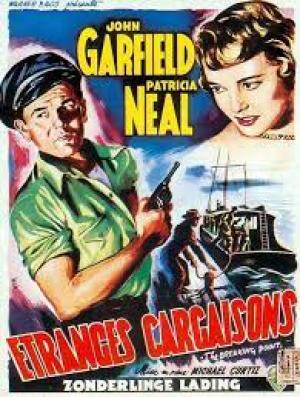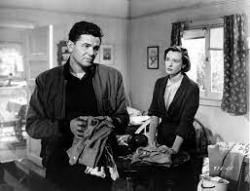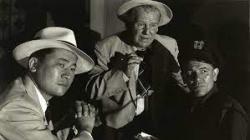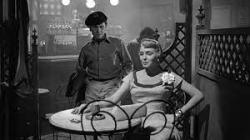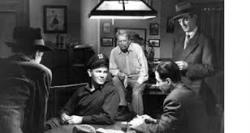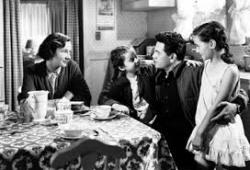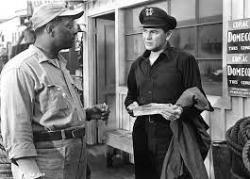Drowning in the Red sea
By Michael J. Roberts
'No actor can really be good until he's reached forty.'
~ John Garfield
Howard Hawks jokingly needled Ernest Hemingway that he could make a film from the author’s generally agreed to be worst book, To Have and Have Not, and then proceeded to do so in 1944. The real joke was that much of the book was thrown aside by Hawks and his talented screenwriters Jules Furthman and William Faulkner, so much so that fellow screenwriter Ranald MacDougall was convinced a good movie could still be made that followed the novel faithfully. MacDougall, who had enjoyed great success with films directed by Michael Curtiz at Warner Brothers, notably Mildred Pierce and The Unsuspected, convinced Jack Warner to green light the project and Warner convinced John Garfield to return to the studio on a two-year deal. Garfield asked for Curtiz to direct (they’d done three films together) and the pair teamed up again for very underappreciated The Breaking Point.
Harry Morgan (John Garfield) is a sea captain off California trying hard to make ends meet on his small charter boat. He takes a gambler and his girlfriend Leona (Patricia Neal) to Mexico, but he’s left out of pocket and with the girlfriend when the gambler secretly flies back alone. In desperation, Harry takes a dodgy job from the odious Duncan (Wallace Ford) and gets into even more trouble. Harry and his trusty deckhand Wesley (Juano Hernández) barely get home with their lives, causing a rift between him and his otherwise steadfast wife Lucy (Phyllis Thaxter) but soon circumstances conspire to bring all the dangerous threads together in a way that threatens Harry and his family.
The Breaking Point has only a cursory resemblance to To Have and Have Not and is a far darker and edgier piece than the Hawks entry, which is a star driven, entertaining, confected conceit. Here the script sizzles and the performances never overwhelm or distract from the sombre tone – it is pure Noir, bible black and bleak. Curtiz keeps the action clean and the story and characterisations clear and sharp in a taut morality tale that bravely muddies the stereotypes and inverts expectations in key areas. Leona is an unapologetic good time girl with a level of self-awareness rare in a Hollywood film of the era – and Wesley is integrated into the story with no semblance of being ‘other’ because of his skin colour, almost unheard of at the time. This is Noir for adults, unafraid of nuance and counterintuitive concepts.
Curtiz, at all times, is in service of the story and of giving us defined characters, as he’s never showy or distracting. His years as a workaholic director in the studio system sometimes disguised his artistic ability but we are never in doubt that this is cinema of a high order, fully realised and compelling. The camera moves beautifully in concert with the action when required and the lighting and camerawork by veteran Ted McCord (who shot John Huston’s Treasure of The Sierra Madre et. al) is atmospheric and note perfect. The script is taut with an undeniable social bite as Harry would be a very recognizable figure to audiences at the time – a damaged, struggling, returned WWII vet trying to integrate back into ‘normal’ society and battling against the demons the war has left him with.
The wonderful performances that Curtiz extracts all enhance the dialogue and the underlying tensions as Harry weighs up doing the right thing against making a living for his doting wife and loving children. Lucy is frantic with worry in juggling the family finances but is the moral centre in urging Harry to not take dirty money. Harry’s chances of clear thinking are not helped by Leona tempting him to test the extent of his fidelity to Lucy, which she sees as a challenge to her siren skills and to assure herself nobody can be as pure of heart as Harry. The distinction is made when Harry will cross a line to provide for his family but not for his own gratification. It’s a distinction that brings Leona’s empty, party girl life into sharp focus, especially when Lucy finds the pair cosying up to each other in a bar and a drunk Harry tries to dig himself out of a hole that just gets deeper. Patricia Neal and Phyllis Thaxter are both superb as the contrasting female forces in Harry’s life and Wallace Ford is effortlessly sleazy as a grifting earworm, but the film belongs to Garfield, who delivers one of his greatest performances under the discerning, demanding Curtiz gaze.
The Breaking Point works so well at every level because the authoritative Curtiz has every aspect in harmony with his artistic vision and technical acuity, able to direct his wonderful cast and crew to bring home a film that never fails to convince. Warner Brothers failed to promote the film because of the HUAC generated ‘Reds Under the Bed’ scare of the time, a kind of early Culture Wars variant. A gossip rag called Red Channels (pushed by quasi-fascist actors like Ward Bond and John Wayne, whose misplaced patriotism helped ruin many fellow film artisans’ careers), named John Garfield as a Communist because his wife was a member of the party some years before. Warner’s panicked and Garfield made a statement before HUAC but refused to ‘name names’ and so he was suspect and subsequently ‘greylisted.’ Warner’s backed away from the two picture association, Garfield had to produce the next film (his last) himself. He wrote a desperate public statement that was published posthumously, ‘I was a sucker for a Red Hook’ but the pressure and frustration culminated in a personal breaking point in the form of a heart attack that killed him at the early age of 39.
The Breaking Point is a great film and a testament to the studio system that produced it, with all its flaws and foibles. Curtiz might never have been given the blessings of the filmerati, but his taste, dedication and skill produced several classics for the ages, and this is one of them.
